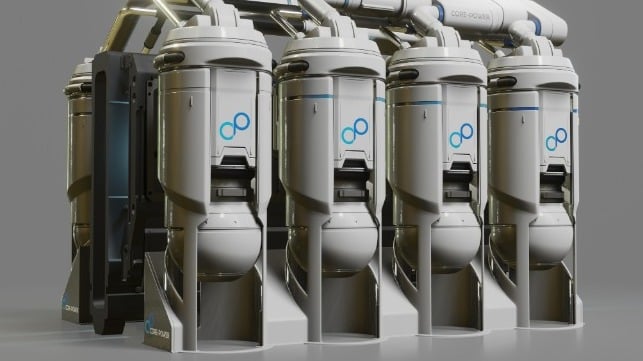Modular Molten Salt Nuclear Power for Maritime Propulsion

Evolving modern modular molten salt nuclear technology incurs comparatively lower cost while using a zero-pressure reactor and lower non-weapons grade uranium fuel. A module measuring 13 feet by 23 feet using a briefcase-sized load of solid fuel weighing 440 pounds could deliver 100 MW of thermal energy for up to 25 years. This potentially cost-competitive technology has potential for future commercial ship propulsion, along with multiple stationary floating power generation applications.
Introduction
Several navies around the world operate scaled-down versions of nuclear power stations aboard ships and submarines to provide propulsion and ancillary power. The onboard nuclear reactors are cooled by high-pressure water and many (including the U.S. Navy’s reactors) require weapons-grade uranium for fuel. While such propulsion technology is suitable for a naval vessel, it has zero application in commercial civilian ship propulsion.
New developments in nuclear technology are based on an old idea involving the molten salt reactor, which can operate free from high pressure water and offer greater long-term operational safety while being suitable for mass production, reducing capital cost.
The technology uses solid non-weapons grade uranium fuel mixed into a chloride salt that melts at 750 degrees F in a pressure-free reactor. Any mixture that should ever leak out of the reactor would cool and solidify, free from any explosion. For maritime propulsion, the technology is comparable to a battery that holds sufficient charge to provide up to 25 years of propulsion at variable power settings. The carbon-free propulsion system saves many years of expense on fuel oil for transoceanic propulsion, providing the maritime industry with an economic and environmental case for its use.
Power output
The modular molten salt reactor delivers up to 100 MW of thermal energy at sufficient temperature to generate steam to activate turbines, which drive electrical generators. Unlike earlier nuclear technology that has to operate continually at constant power output, the molten salt reactor can rapidly adjust its power output and adapt to external demand. A single module could deliver between 4,000 and 26,000 horsepower in either propulsive or stationary floating generator station applications.
The generating system would run on steam power and used seawater to cool the condensers when required when operating at elevated levels of output, with potential for organic Rankine-cycle engines to convert a portion of the exhaust heat to useable power.
Many vessel operators reduce sailing speed to 12 knots to save fuel and reduce engine exhaust emissions, while others sail their ships at 18 to 24 knots. A trio of modular molten salt nuclear reactors connected to steam power conversion could provide sufficient power to sail the largest bulk carriers and the largest container ships economically at elevated speed. Slower ships could use a single molten salt reactor as a primary source of propulsion, perhaps with a back-up piston or turbine engine.
Transportation terminals
Many advances are occurring in electric battery storage technology applied to the transportation sector. This includes short-sea maritime, commercial roadway, railway and even short-haul airline propulsion. There are many locations internationally where maritime ports are located within close proximity to airports, both of which connect directly or indirectly to road and railway transportation. Future battery-electric propulsion provides opportunity to install modular molten salt reactor technology at major transportation terminals to provide energy recharge for a variety of short-sea maritime vessels, commuter aircraft, trucks, buses and even railway technology powered by any of batteries, overhead cable or third rail.
At some locations, there may be scope to use floating technology to carry several modular reactors, the result of seasonal peak traffic at some major transportation terminals. Floating technology could move internationally to spend a few weeks to a few months at locations requiring peak seasonal electric power. Land based modular reactors located next to the ocean would provide base-load power throughout the year. Modular reactors would be able to generate hydrogen for mainly aircraft propulsion, with hydrogen also being made available to some forms of maritime, railway and road vehicle propulsion.
Reusing spent fuel
Molten salt nuclear technology has the potential to reuse spent fuel from older nuclear power stations. It can do so at a very high level of safety, eliminating high-pressure water from the reactor while the molten salt material contains the radiation. Reusing reprocessed spent fuel offers a long-term cost advantage in terms of the expense of hydrocarbon oil fuel. As the fuel approaches expiration, much of it is recyclable via reprocessing while non-recyclable material would be cast in concrete and stored until full expiration after a period of about 100 years.
Conclusion
The modern modular molten salt nuclear reactor has potential to fulfill multiple applications in the maritime sector, including propulsion and floating power generation. It has the potential to power a commercial vessel for the entirety of its normal lifespan without refueling.
The opinions expressed herein are the author's and not necessarily those of The Maritime Executive.

